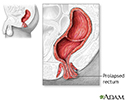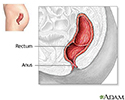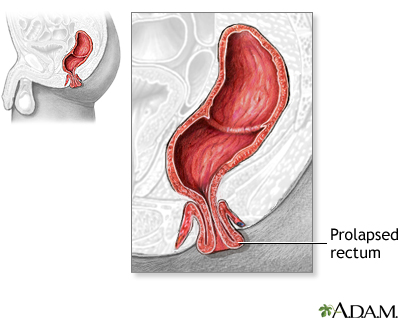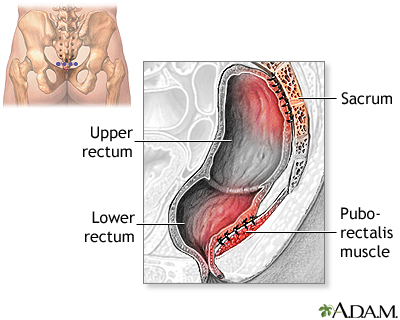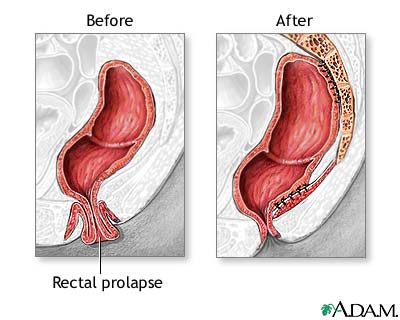Rectal prolapse
Procidentia; Rectal intussusception
Rectal prolapse occurs when the rectum falls and comes through the anal opening.
Causes
The exact cause of rectal prolapse is unclear. Possible causes may include any of the following:
- Defect in the pelvic floor through which hernia may slip down
- Loose muscles of the anal sphincter
- An abnormally long colon
- Downward movement of the abdominal cavity between the rectum and uterus
- Prolapse of the small intestine
-
Constipation
Constipation
Constipation in infants and children occurs when they have hard stools or have problems passing stools. A child may have pain while passing stools o...
 ImageRead Article Now Book Mark Article
ImageRead Article Now Book Mark Article - Diarrhea
- Chronic coughing and sneezing
A prolapse can be partial or complete:
- With a partial prolapse, the inner lining of the rectum bulges partly from the anus.
- With a complete prolapse, the entire rectum bulges through the anus.
Rectal prolapse occurs most often in children under age 6. Health problems that may lead to prolapse include:
-
Cystic fibrosis
Cystic fibrosis
Cystic fibrosis is a disease that causes thick, sticky mucus to build up in the lungs, digestive tract, and other areas of the body. It is one of th...
 ImageRead Article Now Book Mark Article
ImageRead Article Now Book Mark Article - Intestinal worm infections
- Long-term diarrhea
- Other health problems present at birth
In adults, it is usually found with constipation, or with a muscle or nerve problem in the pelvic or genital area.
Symptoms
The main symptom is a reddish-colored mass that sticks out from the opening of the anus, especially after a bowel movement. This reddish mass is actually the inner lining of the rectum. It may bleed slightly and can be uncomfortable and painful.
Exams and Tests
The health care provider will perform a physical exam, which will include a rectal exam . To check for prolapse, provider may ask the person to bear down while sitting on a commode.
Rectal exam
A digital rectal exam is an examination of the lower rectum. The health care provider uses a gloved, lubricated finger to check for any abnormal fin...

Tests that may be done include:
-
Colonoscopy
to confirm the diagnosis
Colonoscopy
A colonoscopy is an exam that views the inside of the colon (large intestine) and rectum, using a tool called a colonoscope. The colonoscope has a sm...
 ImageRead Article Now Book Mark Article
ImageRead Article Now Book Mark Article -
Hemoglobin test
if there is bleeding from the rectum
Hemoglobin test
Hemoglobin is a protein in red blood cells that carries oxygen. The hemoglobin test measures how much hemoglobin is in your blood.
 ImageRead Article Now Book Mark Article
ImageRead Article Now Book Mark Article
Treatment
Call your provider if a rectal prolapse occurs.
In some cases, the prolapse can be treated at home. Follow your provider's instructions on how to do this. The rectum must be pushed back inside manually. A soft, warm, wet cloth is used to apply gentle pressure to the mass to push it back through the anal opening. The person should lie on 1 side in a knee-chest position before applying pressure. This position allows gravity to help put the rectum back into position.
Immediate surgery is rarely needed. In children, treating the cause often solves the problem. For example, if the cause is straining because of dry stools, laxatives may help. If the prolapse continues, surgery may be needed.
In adults, the only cure for rectal prolapse is a procedure that repairs the weakened anal sphincter and pelvic muscles.
Outlook (Prognosis)
In children, treating the cause cures rectal prolapse. In adults, surgery usually cures the prolapse.
When rectal prolapse is not treated, constipation and loss of bowel control may develop.
When to Contact a Medical Professional
Call your provider right away if there is a rectal prolapse.
Prevention
In children, treating the cause usually prevents rectal prolapse from happening again.
References
Kliegman RM, Stanton BF, St Geme JW, Schor NF. Surgical conditions of the anus and rectum. In: Kliegman RM, Stanton BF, St Geme JW, Schor NF, eds. Nelson Textbook of Pediatrics . 20th ed. Philadelphia, PA: Elsevier; 2016:chap 344.
Lembo AJ. Constipation. In: Feldman M, Friedman LS, Brandt LJ, eds. Sleisenger and Fordtran's Gastrointestinal and Liver Disease . 10th ed. Philadelphia, PA: Elsevier Saunders; 2016:chap 19.
Madoff RD. Diseases of the rectum and anus. In: Goldman L, Schafer AI, eds. Goldman's Cecil Medicine . 25th ed. Philadelphia, PA: Elsevier Saunders; 2016:chap 145.
-
Rectal prolapse - illustration
Rectal prolapse may be partial, involving only the mucosa or complete, involving the entire wall of the rectum.
Rectal prolapse
illustration
-
Rectal prolapse repair - series
Presentation
Review Date: 5/11/2016
Reviewed By: Subodh K. Lal, MD, gastroenterologist with Gastrointestinal Specialists of Georgia, Austell, GA. Review provided by VeriMed Healthcare Network. Also reviewed by David Zieve, MD, MHA, Isla Ogilvie, PhD, and the A.D.A.M. Editorial team.

